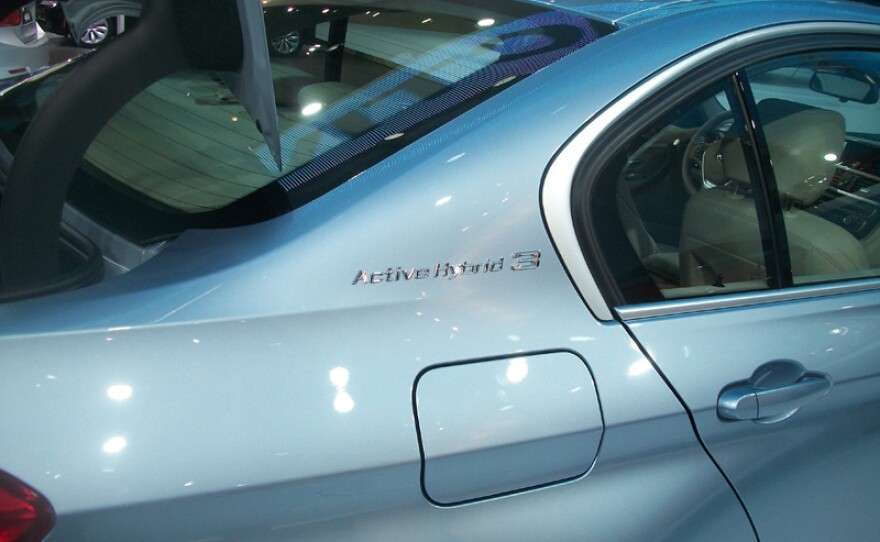http://environmentreport.org/podcasts/2012/MPMGLRC_ENVRPT_20120110_01.mp3
(We are having technical difficulties with the "audio processing" file above. Please listen to the second file. Thank you.)
The last time I attended the Detroit Auto Show was around ten years ago.
Back then, the so-called “green” fuel efficient cars were relegated to a small corner of the Cobo Center. There weren’t that many, and most seemed to be concept cars.
The show seemed to be all about big powerful SUVs, and new cup holder designs, but little, if anything, was changing under the hood.
At the 1992 Detroit Auto Show - toward the beginning of the SUV salad days of the 1990s - then Chrysler chief Bob Lutz created a “Lutzian moment for the ages,” according to AOL Autos.
Lutz wanted to create some splash for Chrysler’s new Jeep Grand Cherokee. He did so -
by driving the first official version of the vehicle off the line of the Jefferson North Plant, through the streets of Detroit, up the granite steps of Cobo -- and then smashing it through a plate-glass window into the hall, scaring the hell out of most of the auto writers and spokesmodels on hand.
Fuel efficiency is the price of entry
My, how things have changed.
Just about every automaker says fuel economy has to be a major part of their new designs.
Reid Bigland heads up the Dodge brand for Chrysler. Here’s how he put it during yesterday’s unveiling of the new, 40 mile per gallon, Dodge Dart.
“First more horsepower, and greater fuel economy. Look, the days of sacrificing horsepower for fuel economy, and vice versa, are long gone. Today, you have to have both, and we do,” said Bigland.
I caught up with Gloria Berquist here at the auto show and asked her what’s changed. She’s the vice-president of the Alliance of Automobile Manufacturers.
“The world has changed, and we all see what a precious resource oil is, and we all see the importance of enhancing our energy security, and so car companies have responded by developing more fuel efficient technologies.”
Changing standards from the federal government
In the past, automakers fought proposals to make federal fuel economy standards tougher.
Known as “Corporate Average Fuel Economy” standards, or CAFE standards, they remained unchanged from 1990 to 2010.
During that whole period, the standard for passenger cars was an average of 27.5 miles per gallon.
Then, in 2007, President George Bush made his famous statement that the country is “addicted to oil.” Shocking many environmentalists, he called for higher fuel economy standards.
In 2008, the country experienced gas at $4 per gallon for the first time. Some of the U.S. automakers were caught off guard, and the bankruptcy and bailout drama ensued.
The writing on the wall was clear. Carmakers had to do better – especially the U.S. carmakers.
Through policies developed by the Obama Administration in cooperation with several auto companies, and for the first time in 20 years, fuel economy standards for passenger cars were bumped up for the 2011 model year (to an average of 30.2 mpg).
And under these new CAFE standards, fuel economy targets will keep getting bumped up each year until 2016.
Thelatest proposed standards (2017 to 2025) calls for auto companies to reach an average of around 54 mpg by 2025.
If that goal were reached, it would go a long way in reducing the country’s dependence on oil, and on reducing the output of carbon dioxide in the U.S.
Why the change of heart?
It’s a big goal, but when the proposal was unveiled last July, many automakers were already on board.
I asked EPA Administrator Lisa Jackson why the companies seem to be on board with these government regulations. She said the companies like the fact that there’s one uniform standard now (companies faced the potential of separate regulations from California and other states, the U.S. EPA, and the U.S. DOT) – and, she said, it’s a standard that can be revisited in future years.
“That’s what we have now and it goes all the way out to 2025. It’s flexible enough that it can be reviewed. But I have no doubt as an engineer myself, that Detroit will meet that challenge and exceed it. And we are now building and designing cars that the world wants to buy,” said Jackson.
The CAFE standards, as proposed, can be revisited in 2018 to see how consumers are reacting to the new vehicles.
Loopholes
Unlike the government fuel efficiency standards in the past, these new CAFE standards take a vehicle’s size into consideration.
If you think about a car taking up a rectangular space on the pavement (with the tires being the corners of the rectangle), that’s the foundation from which the new standards are set.
The standards are more lenient for cars and trucks with larger footprints (it’s harder to make a heavier truck more fuel efficient), and some say these new standards create an incentive for automakers to build bigger.
Katie Whitefoot is Senior Program Officer at the National Academy of Engineering. She and Steven Skerlos researched the new standards and their potential impact on vehicle size. The study was done at the University of Michigan (while Whitefoot was Ph.D. candidate there).
Whitefoot said their research concluded that “because the fuel economy standards are dependent on the sizes of the vehicles produced, we're not actually guaranteed to see the numbers that are projected."
She says the standards will result in significant increases in fuel economy, “but it doesn't increase as much as it could have.”
The difference if this type of incentive didn’t exist, is substantial, she said.
“And just to put that into perspective the additional CO2 emissions generated because this incentive exists is equivalent to adding approximately 3 to 10 coal fired power plants to the grid each year - each of which could power a city the size of Detroit," said Whitefoot.
It’s still a big goal
Still, shooting for a goal of around 54 mpg by 2025 is a big increase from a passenger car standard that sat at 27.5 mpg for 20 years.
To meet that goal, I’d assumed that vehicles would all have to be electric or hybrids.
Gloria Berquist of the Alliance of Automobile Manufacturers mostly agrees. She feels that hybrids and electric vehicles will have to be a big part of auto sales to meet the 54 miles per gallon standard.
In her mind, the question is - will people buy these cars in the future?
“We’re investing so much money,” said Berquist. “Even by the government’s estimates, these new standards are going to cost the industry on the order of $200 billion. So that’s a large number, and we certainly need consumers to buy these new vehicles so that we can recoup some of the investments and certainly avoid have them sitting unsold on dealer’s lots.”
In 2011, hybrid and electric cars made up around 2 percent of auto sales in the U.S.
But when I asked David Friedman about what cars will be like in 2025, he had a different take.
Friedman is the deputy director of the Clean Vehicles Program for the Union of Concerned Scientists.
He said gas engines will definitely still be around.
"Almost every single car on the road will still be burning gasoline in 2025. And in fact, most of the new cars on the road won't even have to be hybrids under this standard," said Friedman.
The fact that these goals are so reachable is one reason why the UCS was pushing for a 60 mpg standard by 2025, Friedman says.
“Under these new standards, consumers will be able to choose cars of the same size, the same performance and the same or even better safety, than they have today,” he said. “The main difference they'll notice is they'll be spending thousands of dollars less on gasoline."
Friedman says to save on fuel consumption; companies will make gas engines more efficient. Engines that can turn off cylinders when they’re not needed, or engines that will shut off at a stop light. He also says better transmissions, sleeker aerodynamics, and better tires will be used to meet the fuel economy expectations of the future.
Increased fuel efficiency standards seem to be widely accepted by the American public. In a Consumer Reports poll released last November, 93 percent of adult car owners wanted to see stricter fuel efficiency standards.


















